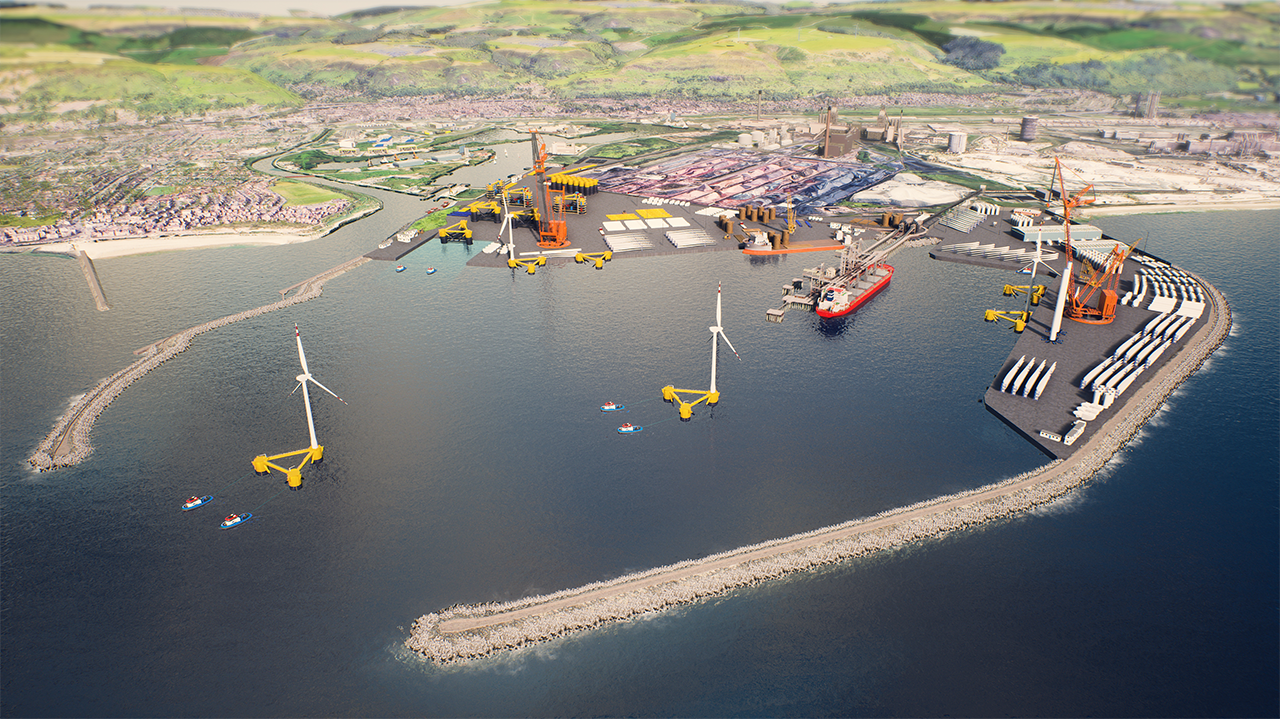Computer generated image of what a fully realised vision of the Future Port Talbot could look like. Note that the representations of the project will evolve as developer requirements and technology parameters become clearer.
Associated British Ports (ABP), the UK’s leading port operator, today welcomed the decision by the Department of Energy Security and Net Zero to advance the Future Port Talbot project to the Primary List phase of the Floating Offshore Wind Manufacturing Investment Scheme (FLOWMIS).
Henrik L. Pedersen, Chief Executive Officer of Associated British Ports, said “ABP is pleased that the UK Government is supporting the ambitious plan to transform the port of Port Talbot into a major hub for Floating Offshore Wind and green energy development. The FLOWMIS award, alongside significant ABP investment of more than £500 million, will begin to unlock a projected £1 billion of investment in Port Talbot and the surrounding area. This will develop a green economic hub supporting and creating nearly 10,000 jobs in South Wales and across the wider UK supply chain.”
“Today’s decision comes at a crucial time for Port Talbot and South Wales more broadly. The funding announced will help secure the region’s future as a hub of next-generation UK industry, providing thousands of jobs in the green economy right across the supply chain.”
“ABP is grateful that its bid was also supported by local members of both UK and Welsh Parliaments, Neath Port Talbot Council, the Welsh Government and by local, national and international businesses in the floating offshore wind supply chain. We look forwarding to working closely with all stakeholders as we progress into the due diligence phase of the FLOWMIS process and work to deliver our plans at pace.”
ABP’s Future Port Talbot project would see the port transformed into a major hub for the manufacturing, assembly, and integration of Floating Offshore Wind (FLOW) components for projects in the Celtic Sea. This represents a major growth opportunity for the UK, with the prospect of creating a world-class manufacturing and supply chain hub in Port Talbot as well as providing opportunities for broader green energy and industrial activity, which will serve as a catalyst for wider economic regeneration in the South Wales industrial cluster.
Port Talbot has the scale and technical capabilities to fully unlock the opportunity of Floating Offshore Wind in the Celtic Sea. It will also be able to act as a ‘hub’ for a wider network of ports across South Wales and the South West.
ABP now wants to work at pace with Governments in London and Cardiff, as well as other organisations involved in the process, to take forward the Port Talbot development, incorporating the latest knowledge and experience of what in FLOW is a nascent industry.
ABP also welcomes the decision to move forward the FLOWMIS bid of the Port of Cromarty Firth to Primary List phase. ABP has recently signed an agreement concerning parcels of land in the Cromarty Firth area and is investigating options for development to support FLOW and green energy development there. Today’s announcement is a recognition of the strength of the ‘Team Cromarty’ offering to support the major ambitions for green growth in Scotland.
The Port Talbot investment is part of ABP’s sustainability strategy, ‘Ready for Tomorrow’, launched in 2023. The strategy sets out plans for ABP to invest £2 billion into decarbonising its own operations by 2040 as well as supporting large-scale green energy infrastructure and industrial decarbonisation projects. These other projects include major green ammonia / hydrogen and CCS projects in the Humber and offshore wind projects in the Humber and East Anglia amongst others.


